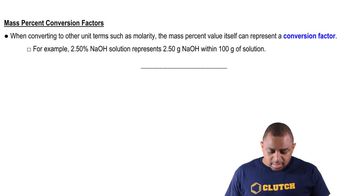Give the empirical formula of each of the following compounds if a sample contains (c) 26.56% K, 35.41% Cr, and 38.03% O by mass.
Ch.3 - Chemical Reactions and Reaction Stoichiometry
Chapter 3, Problem 46c
Determine the empirical formula of each of the following compounds if a sample contains (c) 89.14% Au and 10.86% O by mass.

Verified Solution
Video duration:
1mWas this helpful?
Key Concepts
Here are the essential concepts you must grasp in order to answer the question correctly.
Empirical Formula
The empirical formula of a compound represents the simplest whole-number ratio of the elements present in that compound. It is derived from the percentage composition of each element, allowing chemists to understand the basic composition without detailing the molecular structure.
Recommended video:
Guided course

Empirical vs Molecular Formula
Molar Mass
Molar mass is the mass of one mole of a substance, typically expressed in grams per mole (g/mol). It is crucial for converting the mass percentages of elements into moles, which are then used to determine the empirical formula by finding the simplest ratio of the elements.
Recommended video:
Guided course

Molar Mass Concept
Conversion from Mass Percent to Moles
To find the empirical formula, the mass percent of each element must be converted to moles. This is done by dividing the mass of each element by its molar mass. The resulting values are then simplified to the smallest whole-number ratio, which gives the empirical formula.
Recommended video:
Guided course

Mass Percent Conversion
Related Practice
Textbook Question
1450
views
Textbook Question
Determine the empirical formula of each of the following compounds if a sample contains (a) 3.92 mol C, 5.99 mol H, and 2.94 mol O
650
views
Textbook Question
Determine the empirical formula of each of the following compounds if a sample contains (b) 12.0 g calcium and 2.8 g nitrogen
769
views
Textbook Question
Determine the empirical formulas of the compounds with the following compositions by mass: (a) 74.0% C, 8.7% H, and 17.3% N
501
views
Textbook Question
Determine the empirical formulas of the compounds with the following compositions by mass: (b) 57.5% Na, 40.0% O, and 2.5% H
723
views
Textbook Question
Determine the empirical formulas of the compounds with the following compositions by mass: (a) 42.1% Na, 18.9% P, and 39.0% O
1243
views
